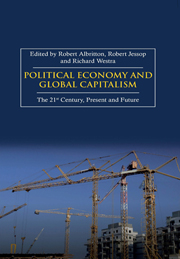Book contents
- Frontmatter
- Contents
- List of Abbreviations
- Notes on Contributors
- Introduction: Political Economy and Global Capitalism
- Part 1 Political Economy of the Present
- Introduction
- 1 Theorizing the Contemporary World: Robert Brenner, Giovanni Arrighi, David Harvey
- 2 Technological Dynamism and the Normative Justification of Global Capitalism
- 3 Eating the Future: Capitalism Out of Joint
- 4 What follows Neo-liberalism? The Deepening Contradictions of US Domination and the Struggle for a New Global Order
- 5 Monetary Policy in the Neo-liberal Transition: A Political Economy Critique of Keynesianism, Monetarism and Inflation Targeting
- Part 2 Political Economy of a Progressive Global Future
- Index
4 - What follows Neo-liberalism? The Deepening Contradictions of US Domination and the Struggle for a New Global Order
from Part 1 - Political Economy of the Present
Published online by Cambridge University Press: 05 March 2012
- Frontmatter
- Contents
- List of Abbreviations
- Notes on Contributors
- Introduction: Political Economy and Global Capitalism
- Part 1 Political Economy of the Present
- Introduction
- 1 Theorizing the Contemporary World: Robert Brenner, Giovanni Arrighi, David Harvey
- 2 Technological Dynamism and the Normative Justification of Global Capitalism
- 3 Eating the Future: Capitalism Out of Joint
- 4 What follows Neo-liberalism? The Deepening Contradictions of US Domination and the Struggle for a New Global Order
- 5 Monetary Policy in the Neo-liberal Transition: A Political Economy Critique of Keynesianism, Monetarism and Inflation Targeting
- Part 2 Political Economy of a Progressive Global Future
- Index
Summary
This chapter explores neo-liberalism, its forms, its periodization, and its future in the context of the changing dynamics of the capitalist world market. It focuses particularly on American neo-liberalism and foreign economy policy because the US remains the dominant neo-liberal power. It argues that, notwithstanding the loss of American economic hegemony and the growing challenge to its domination across a number of fields, US economic and political power retains disproportionate significance. This is because the new forms of financial domination promoted by the federal government, its associated international economic apparatuses, and transnational financial capital are still ‘ecologically dominant’ in shaping the world economy and global order more generally. The chapter has five parts. It first addresses issues of periodization that bear on the capitalist world market and neo-liberalism, then defines neo-liberalism and distinguishes its four main forms. Subsequently, it proceeds to discuss four forms of economic determination broadly considered, argues that the logic of American neo-liberalism is ecologically dominant in the world market, and concludes with some general remarks on the contradictions and limits of American domination.
Questions of Periodization
To ask what follows neo-liberalism is to pose a problem of periodization. The primary purpose of any periodization is to interpret an otherwise undifferentiated ‘flow’ of historical time by classifying events and/or processes in terms of their internal affinities and external differences in order to identify successive periods of relative invariance and the transitions between them (cf. Elchardus, 1988, p. 48).
- Type
- Chapter
- Information
- Political Economy and Global CapitalismThe 21st Century, Present and Future, pp. 67 - 88Publisher: Anthem PressPrint publication year: 2007
- 7
- Cited by



